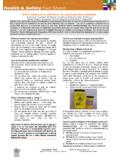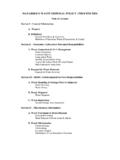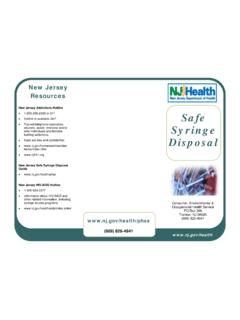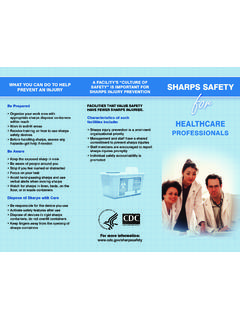Transcription of Ensuring safe injections - WHO
1 3 Ensuring safe injections3: Ensuring safe injectionsAbout this module discusses practices that health workers should follow to ensure that they deliver immunization injections in the safest are considered safe for: the child, when health workers use sterile needles and syringes and appropriate injection techniques; the health worker, when he or she avoids needle-stick injuries; and waste handlers and the community, when used injection equipment is disposed of properly and does not cause injuries or 3: Ensuring safe injections (3)2 Immunization in practiceContents1.
2 Using safe injection equipment and techniques ..(3) Types of injection equipment ..(3) Estimating AD and RUP syringe needs ..(3) Giving the right vaccine safely ..(3) Simple ways to improve injection safety ..(3)92. Preventing needle-stick injuries ..(3) Minimizing the need to handle needles and syringes ..(3) Handling syringes and needles safely ..(3) Setting up the immunization work area to minimize risk of injury ..(3) Positioning children correctly for injections ..(3) Practising safe disposal of all medical sharps waste.
3 (3)123. Disposing of used syringes and needles ..(3) Why is it important to handle sharps waste properly? ..(3) Safety boxes ..(3) Using safety boxes ..(3) Disposing of filled safety boxes ..(3)17 Annex Unsafe immunization practices ..(3)22 Module 3: Ensuring safe injectionsImmunization in practice(3)31 Using safe injection equipment and Types of injection equipmentThe types of equipment used to administer injectable vaccines are listed in Table Note that auto-disable syringes are the endorsed choice, as explained in the 1999 joint WHO-UNICEF-UNFPA statement given in Box Types of equipment used to administer injectable vaccinesEquipmentRemarksAuto-disable (AD)
4 Syringesequipment of choicePrefilled AD injection devicesavailable for some antigens onlyReusable syringes and needles not recommendedHypodermic syringes with reuse prevention feature (RUP) and needlesfor mixing purposes onlyBox 1. WHO-UNICEF-UNFPA joint statement on the use of auto-disable syringes in immunization services The auto-disable syringe, which is now widely available at low cost presents the lowest risk of person-to-person transmission of bloodborne pathogens (such as HepB or HIV) because it cannot be reused. The auto-disable syringe is the equipment of choice for administering vaccines, both in routine immunization and mass campaigns.
5 Auto-disable (AD) syringes for immunizationAD syringes are recommended for all types of immunization sessions not just because they can only be used once and can reduce disease transmission from contaminated equipment, but also because they are disposable and save time previously spent on syringes for fixed-dose immunization have the following main features: a self-locking mechanism that allows only one use; this is called a reuse prevention feature (RUP) a fixed needle (usually 23G x 25 mm, but various sizes are manufactured) a specific scale mark showing only the quantity to be administered.
6 Module 3: Ensuring safe injections (3)4 Immunization in practiceEach AD syringe is sterilized and sealed in plastic or paper blisters by the manufacturer. All AD syringes have plastic caps to keep the needle sterile; some also have caps on the plungers. They are supplied in three volumes: ml for most vaccines and ml or ml for syringes have different types of locking mechanisms that are triggered at different times. Some syringes lock their plunger at the start of the injection while others do so at the end. AD syringes that lock at the start are preferred since they completely prevent reuse.
7 Some AD syringes are retractable, meaning that the needle can be pulled in the barrel. This mechanism adds stick injury protection (SIP) to reduce the risk of needle-stick steps for using AD syringesEach type of AD syringe requires a specific technique for its use. But for all types, the plunger can go back and forth only once. Health workers should not move the plunger unnecessarily and should not inject air into a vaccine vial when using an AD syringe, as this might disable general steps to follow when using AD syringes are given below.
8 Note that the steps should should be adapted depending on manufacturer s instructions for the type of syringe being Remove the syringe from its plastic wrapping (peel the package open from the syringe plunger end), or detach the plastic Take off the needle cap without touching the Insert the needle in the vaccine vial its tip should be in the lowest part or bottom of the Pull the plunger back to fill the syringe just past the ml or ml or ml Remove the needle from the vial. To remove air bubbles, hold the syringe upright and tap the barrel.
9 Then carefully push the plunger to the volume mark. For the last dose of a multi-dose vial, keep the needle tip in the fluid at all times, making sure to empty the full contents of the Proceed with the injection at the appropriate site (see Module 5 (Managing an immunization session), Section 4 for details on injection technique).7. Push the plunger forward and inject the vaccine. At the beginning or just at the end of the injection , the plunger will automatically lock so the syringe cannot be Do not recap the needle after 3: Ensuring safe injectionsImmunization in practice(3)59.
10 Dispose of the needle and syringe in a safety box, which is a leak-proof, puncture-resistant container for sharps syringes with reuse prevention features (RUP)RUP syringes are disposable syringes with self-locking mechanisms that allow only one use. They are the recommended choice for reconstituting vaccines, just as AD syringes are recommended for administering steps for using RUP syringes for reconstituting vaccinesJust as with AD syringes , each type of RUP syringe requires a specific technique for its use. But for all types, the plunger can go back and forth only once and so health workers should take care not to move it steps to follow when using RUP syringes are given below.













